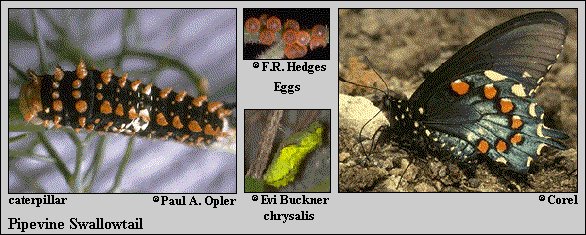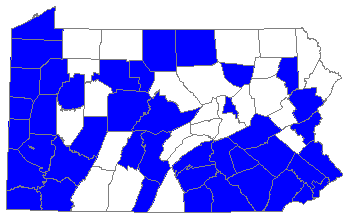 |
 

 |



Pipevine Swallowtail (Battus philenor [Linnaeus])
Wing span: 2 3/4 - 5 inches (7 - 13 cm).
Identification: Upper surface of hindwing iridescent blue or blue-green. Underside of hindwing with submarginal row of 7 round orange spots in iridescent blue field.
Life history: Adult males patrol likely habitat in search of receptive females. Females lay batches of eggs on underside of host plant leaves. Caterpillars feed in small groups when young but become solitary when older. Wintering is by the chrysalis.
Flight: In the East and California, adults fly primarily in late spring and summer, but the butterfly is commoner in late summer and fall in the South and Southwest. Where lack of freezing temperatures permit, adults may fly continuously. In lowland tropical Mexico they may be found in any month.
Caterpillar hosts: Pipevines (Aristolochia species), including Aristolochia californica, A. serpentaria and others.
Adult food: Solely nectar from flowers including thistles (Cirsium species), bergamot, lilac, viper's bugloss, common azaleas, phlox, teasel, azaleas, dame's-rocket, lantana, petunias, verbenas, lupines, yellow star thistle, California buckeye, yerba santa, brodiaeas, and gilias.
Habitat: A wide variety of open habitats, open woodland, and woodland edges.
Range: Rare stray to Canada (s. Manitoba). Tropical lowlands south to southern Mexico.
Conservation: Normally not of high conservation concern, although states at northern limits have listed under state law. These listings are of dubious value where species is not a permanent resident.
Management needs: Management of habitats to ensure survival of host plant colonies is the only possible concern.
The Nature Conservancy Global Rank: G5 - Demonstrably secure globally, though it may be quite rare in parts of its range, especially at the periphery.
References:
Opler, P. A. and G. O. Krizek. 1984. Butterflies east of the Great Plains.
Johns Hopkins University Press, Baltimore. 294 pages, 54 color plates.
Opler, P. A. and V. Malikul. 1992. A field guide to eastern butterflies.
Peterson field guide #4. Houghton-Mifflin Co., Boston. 396 pages, 48 color
plates.
Scott, J. A. 1986. The butterflies of North America. Stanford University Press,
Stanford, Calif. 583 pages, 64 color plates.
Author: Jane M. Struttmann
State and Regional References:
Glassberg, J. 1993. Butterflies Through Binoculars: A Field Guide to
Butterflies in the Boston-New York-Washington Region. Oxford Univ. Press,
New York, N.Y. 160 pp.
Layberry, R.A., Hall, P.W. & Lafontaine, D.J., 1998. The Butterflies of
Canada. University of Toronto Press, Toronto, ON. 280 pp.
Opler, P.A. 1998. A field guide to eastern butterflies, revised format.
Houghton Mifflin Co., Boston.
Shapiro, A.M. 1966. Butterflies of the Delaware Valley. American Entomological
Society Special Publication. Philadelphia, PA. 79 pp.
Tietz, H.M. 1952. The Lepidoptera of Pennsylvania. The Pennsylvania State
College School of Agriculture Agricultural Experiment Station. State
College, PA. 194 pp.
Wright, D.M. 1995, Atlas of Pennsylvania Butterflies. Special Private
Publication, Lansdale, PA. 22 pp.

